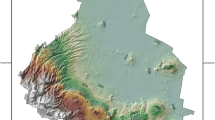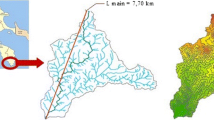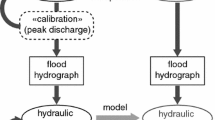Abstract
Landfills are mainly located in lowland areas close to settlements inducing flood risk of potential environmental contamination and adverse health effects. During recent flood events, numerous landfill sites were reportedly exposed to inundations, leading to erosion of landfilled material and release of pollutants threatening humans and the environment. Although emissions from landfills under regular operating conditions are well investigated, the behaviour and associated emissions in case of flooding are widely unknown. To enable environmental risk management, flood-prone landfills must be identified to establish priorities for subsequent protection and mitigation measures. This paper presents two flood risk assessment approaches at different spatial scales: a macro-scale assessment approach (MaSA) and a micro-scale assessment approach (MiSA). Both methodologies aim to determine the proportion of landfills endangered by flooding, and evaluate the impacts. The latter are expressed by means of risk categories (minor to serious) of impacts that flooded sites might have on humans and the environment. The evaluation of 1,064 landfills in Austria based on MaSA yields roughly 30 % of landfills located within or close to flood risk zones. Material inventories of 147 sites exposed to flooding are established, and potential emissions during a flood event are estimated. Three representative case study areas are selected and investigated in detail by applying the MiSA approach based on 2D hydrodynamic models to calculate flow depths and shear stress and by developing emission scenarios to validate the macro-scale screening approach (MaSA). The applications of MiSA and MaSA outlines that hazardous emissions due to flooding can lead to significant impacts on the environment. Uncertainty associated with related processes and data sources is considerably high. Nevertheless, both MiSA and MaSA provide a decision support tool to identify landfills with imminent risk for humans and the environment. Therefore, the described methodologies provide toolsets to enable environmental risk reduction by applying a priority-ranked flood risk management.



Similar content being viewed by others
References
Ackermann F, Bergmann H, Schleichert U (1983) Monitoring of heavy metals in coastal and estuarine sediments—a question of grain-size: <20 μm versus <60 μm. Environm Technol Lett 4:317–328
AFEA (2008a) Austrian Federal Environment Agency—Umweltbundesamt, GIS data supply http://www.umweltbundesamt.at/umweltschutz/altlasten/
AFEA (2008b) Austrian Federal Environment Agency—Umweltbundesamt, Altlast T10 “Deponie Pflach” Beurteilung der Sicherungsmaßnahmen. www. umweltbundesamt.at
Baborowski M, Förstner U, Kern U, Netzband A, Pütz H, Zerling L, Westrich B, Asselmann N, Böhme M, Büttner O, Bungartz H, Engelhardt C, Haag I, Heise S, Jacub G, Krüger A, Krüger F, Matthies M, Middelkoop H, Otte-Witte K, Prochnow D, Prohaska S, Rode M, Schulz M, von Tümpling W, Wurms S (2011) Kontaminierte Gewässersedimente—strategie, Fallbeispiele, Empfehlungen. DWA-Themen T3/2011, Bad Tölz: Offsetdruck Bokor: 3
Baccini P, Henseler G, Figi R, Belevi H (1987) Water and element balances of municipal solid waste landfills. Waste Manage Res 5:483–499
Belevi H, Baccini P (1989) Long-term behaviour of municipal solid waste landfills. Waste Manage Res 7:43–56
BEV (2008) Bundesamt für Eich- und Vermessungswesen, GIS data supply digital elevation model, http://www.bev.gv.at
Blackburn J, Steffler P (2002) River2D, Two-dimensional depth averaged model of river hydrodynamics and fish habitat, introduction to depth averaged modelling and user’s manual, University of Alberta, http://www.river2d.ualberta.ca/
Blight GE, Fourie A (2005) Catastrophe revisited—disastrous flow failures of mine and municipal solid waste. Geotech Geol Eng 23:219–248
BMLFUW (1996) Bundesgesetzblatt für die Republik Österreich, 186. Verordnung: Allgemeine Begrenzung von Abwasseremissionen in Fließgewässer und öffentliche Kanalisationen (AAEV). Wien
BMLFUW (2006a) Federal waste management plan 2006. Federal Ministry of Agriculture and Forestry, Environment and Water Management, Vienna, p 320
BMLFUW (2006b) Hochwasserrisikozonierung Austria—HORA, Bundesministerium für Land- und Forstwirtschaft, Umwelt und Wasserwirtschaft, www.hochwasserrisiko.at
BMLFUW (2007) digital hydrologic Atlas Austria http://www.boku.ac.at/iwhw/hao/
BMLFUW (2008a) Kosten-Nutzen-Untersuchung im Schutzwasserbau: Richtlinie, available online: impressum.lebensministerium.at/filemanager/download/26589/
BMLFUW (2008b) Austrian landfill directive. Verordnung über die Ablagerung von Abfällen, http://www.lebensministerium.at/article/articleview/26629/1/6969/
Bogner J, Spokas K (1993) Landfill CH4: rates, fates, and role in global carbon cycle. Chemosphere 26:369–386
BUWAL (1999) Risikoanalyse bei gravitativen Naturgefahren—Methode. Umwelt-Materialien Nr. 107/I, Naturgefahren: Bern: Bundesamt für Umwelt, Wald und Landschaft
Christensen TH, Kjeldsen P, Lindhardt B (1996) Gas-generating processes in landfills. In: Christensen TH (ed) Landfilling of waste: biogas. E&FN Spon, London, pp 27–44
Clevers JGPW, Kooistra L, Salas EAL (2004) Study of heavy metal contamination in river flood-plains using the red-edge position in spectroscopic data. Int J Remote Sens 2004(25):883–3895
Curtis JA, Whitney JW (2003) Geomorphic and hydrologic assessment of erosion hazards at the Norman municipal landfill, Canadian river floodplain, Central Oklahoma. Environ Eng Geosci 2003(9):241–253
Döberl G, Huber R, Fellner J, Cencic O, Brunner PH (2002) Neue Strategien zur Nachsorge von Deponien und zur Sanierung von Altlasten (Projekt STRANDEZA). Technische Universität Wien, Abteilung Abfallwirtschaft und Stoffhaushalt, p 267
Ehrig HJ, Krümpelbeck I (2001) The emission behaviour of old landfills in the aftercare phase. In: Christensen TH, Cossu R, Stegmann R (eds) Proceedings Sardinia 2001, eight international waste management and landfill symposium. IV. CISA, S. Margherita di Pula, pp 313–323
EU (2007): Richtlinie 2007/60/EG des europäischen Parlaments und des Rates über die Bewertung und das Management von Hochwasserrisiken
Geller W, Ockenfeld K, Böhme M, Knöchel A (2004) Schadstoffbelastung nach dem Elbe-Hochwasser 2002. Final report of the ad-hoc-project ‘Schadstoffuntersuchungen nach dem Hochwasser vom August 2002—Ermittlung der Gefährdungspotentiale an Elbe und Mulde’. UFZ—Umweltforschungszentrum Leipzig-Halle GmbH, Magdeburg
Geoland (2009) Online geo-database of the federal states in Austria, www.geoland.at
Habersack H, Moser A (2003) Ereignisdokumentation—Hochwasser August 2002, final report. University of Natural Resources and Applied Life Sciences, Vienna, pp 184
Hydrotec (2008) Das 2D Strömungsmodell Hydro_AS-2D, Hydrotec Igenieurgesellschaft http://www2.hydrotec.de/unternehmen/hydrothemen/hydrothemen07/hydro-as-2d/
Klink RE, Ham RK (1982) Effects of moisture movement on methane production in solid waste landfill samples. Res Conserv 8:29–41
Krammer HJ, Domenig M, Striedner J, Vogel G (1992) Materialien zum Bundesabfallwirtschaftsplan (BAWP), Band 3: Kommunale Abfälle. Bundesministerium für Umwelt, Jugend und Familie, Wien, p 180
Kylefors K, Andreas L, Lagerkvist A (2003) A comparison of small-scale, pilot-scale and large-scale tests for predicting leaching behaviour of landfilled wastes. Waste Manage 23:45–59
Laner D, Fellner J, Brunner PH, Neuhold C, Kolesar C (2008) Environmental relevance of flooded MSW landfills in Austria, In: ISWA/WMRAS, ISWA/WMRAS world congress 2008—East meets Waste, Singapore Nov 3–6
Laner D, Fellner J, Brunner PH (2009) Flooding of municipal solid waste landfills—a long-term environmental hazard? Sci Total Environ 407(12):3674–3680
Lange G, Lechner K (1993) Gewässerregelung and Gewässerpflege—Naturnahe Ausbau und Unterhaltung von Fließgewässern. Verlag Paul Parey, 3.Auflage, Hamburg/Berlin
Merz B (2006) Hochwasserrisiken—Grenzen und Möglichkeiten der Risikoabschätzung, E. Schweizerbart’sche Verlagsbuchhandlung (Näglele u. Obermiller), Stuttgart
Merz R, Blöschl G, Humer G, Hofer M, Hochhold A, Wührer W (2006) Hochwasserrisikoflächen Österreich (HORA)—hydrologische Arbeiten (technical report). Institut für Wasserbau und Ingenieurhydrologie, TU Wien, Wien
Merz R, Blöschl G, Humer G (2008) National flood discharge mapping in Austria. Nat Hazards 46:53–72
Messner F, Penning-Rowsell E, Green C, Meyer V, Tunsall S, van der Veen A (2007) Evaluating flood damages: guidance and recommendations on principles and methods, report number T09-06-01, www.floodsite.net
Nachtnebel HP, Holzmann H, Neuhold C, Haberl U, Kahl B, Bichler A (2009) GEDES: Gefährdung durch Deponien und Altablagerungen im Hochwasserfall—Risikoanalyse und Minimierung—Teilbericht 2, Wien
Neuhold C (2010) Revised flood risk assessment: quantifying epistemic uncertainty emerging from different sources and processes. Dissertation, University of Natural Resources and Life Sciences, Vienna, Austria
Neuhold C, Nachtnebel HP (2010) Assessing flood risk associated with waste disposals: methodology, application and uncertainties. Nat Hazards. doi:10.1007/s11069-010-9575-9
Neuhold C, Stanzel P, Nachtnebel HP (2009) Incorporating river morphological changes to flood risk assessment: uncertainties, methodology and application. Nat Hazards Earth Syst Sci 9:789–799
Ockenfeld K, Böhme M, Knöchel A, Geller W (2005) Displacement of pollutants during the River Elbe flood in August 2002—introduction to special issue. Acta Hydrochim Hydrobiol 33:391–394
Prat N, Toja J, Sola C, Burgos MD, Plans M, Rieradevall M (1999) Effect of dumping and cleaning activities on the aquatic ecosystems of the Guadiamar River following a toxic flood. Sci Total Environ 1999(242):231–248
Rank G, Kardel K, Pälchen W, Greif A (2002): Schadstoffbelastungen im Mulde- und Elbe-Einzugsgebiet nach dem Augusthochwasser 2002. Statusseminar des BMBF-Ad-hoc-Verbundprojektes Schadstoffbelastung im Mulde- und Elbe-Einzugsgebiet, Freiberg, 2003, pp 114–120
Stegmann R, Heyer KU (1995) Langfristiges Gefährdungspotential und Deponieverhalten von Ablagerungen. Statusseminar Deponiekörper, BMBF
U.S. Environmetal Protection Agency (1997) Damage cases and environmental releases from mines and mineral processing sites. U.S. Environmental Protection Agency, Office of Solid Waste, Washington D.C., 1997
Young S, Balluz L, Malilay J (2004) Natural and technologic hazardous material releases during and after natural disasters: a review. Sci Total Environ 322:3–20
Zhang Y (2006) Technical report no. NCCHE-TR-2006-03, CCHE-GUI—graphical users interface for NCCH model, user’s manual—version 3.0, NCCHE, The University of Mississippi
Zhang Y, Jia Y (2007) Technical report no. NCCHE-TR-2007-01, CCHE-Mesh: 2D structured generator, user’s manual—version 3.0, NCCHE, The University of Mississippi
Acknowledgments
The author wishes to express his gratitude to the federal governments of Salzburg and Tirol for providing the model set-ups for case study 2 and case study 3. This project was funded by the Federal Ministry of Transport, Innovation and Technology within the framework of the KIRAS Safety Research Program. Additional support was provided by the Federal Ministry of Agriculture, Forestry, Environment and Water Management.
Author information
Authors and Affiliations
Corresponding author
Additional information
This article has previously been published as February 2013, Volume 65, 1 Issue 3, pp 2015-2030. DOI 10.1007/s11069-012-0459-z.
Rights and permissions
About this article
Cite this article
Neuhold, C. Identifying flood-prone landfills at different spatial scales. Nat Hazards 68, 1425–1440 (2013). https://doi.org/10.1007/s11069-013-0562-9
Received:
Accepted:
Published:
Issue Date:
DOI: https://doi.org/10.1007/s11069-013-0562-9




